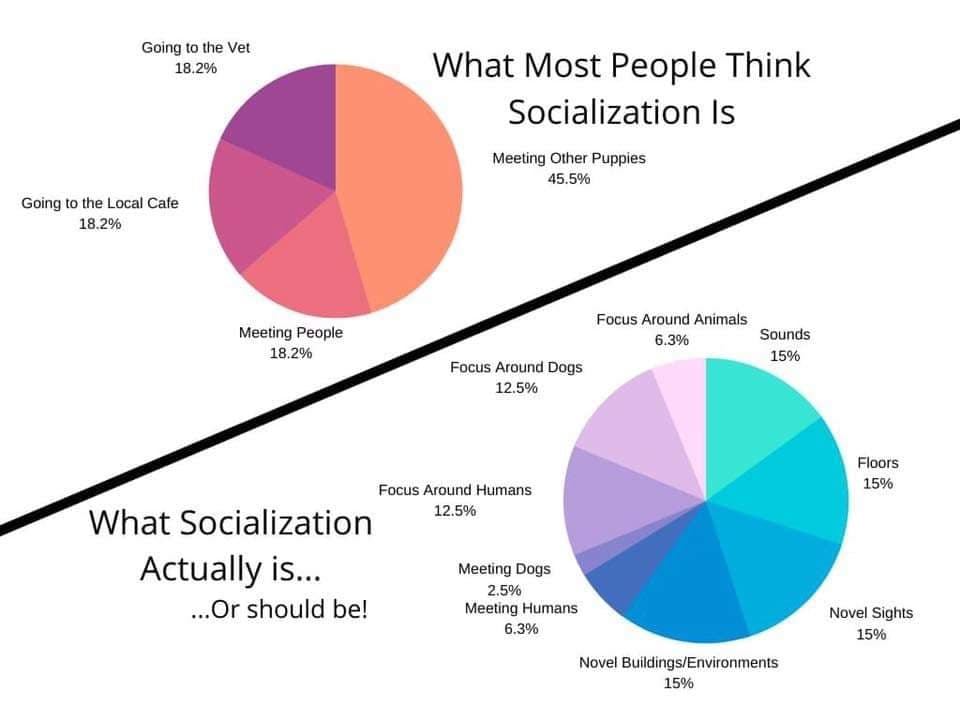Socialization of puppies

SOCIALISATION ADVICE
Socialisation is a term that is often used in dog training books, in dog magazines and by breeders and trainers. But what does it actually mean and how will it affect you as a new puppy owner?
Like human children, puppies are not born with the social skills that they require to live with their family, be that a canine family or a human one. The term "socialisation" in simple terms means the learning process that a puppy must undergo in order to learn key life skills to ensure that it is happy and confident in its environment, and can communicate effectively within its social group. We ask a huge amount from our dogs in their role as a companion animal, as not only do they need to understand humans and the human world, they also need to become fluent in the language of dog.
This involves having pleasant social interactions with adults, children, vets, adult dogs and other animals, as well as careful exposure to different situations in the environment like traffic, crowds, travelling in the car, vacuum cleaners and any sights and sounds it will have to cope with in life. It is so important that this is done thoroughly and correctly when your puppy is still young and he is young enough to happily accept new things.
Puppies that have been socialised effectively in these early weeks are far less likely to react negatively to new situations, noises, people, dogs and animals than their counterparts, who have not had these important early experiences. A well socialised puppy is far more likely to integrate easily into your life, therefore making your life together much more enjoyable and rewarding.
There are two parts to socialisation and both are equally important. The first is teaching the puppy to be social with people and other dogs, while the other (called habituation) is about teaching all the things we want the puppy to ignore and not be worried about (noises, traffic, household objects etc.).
Being a companion is the hardest job we ever ask a dog to do as our expectations are so high. We want dogs to get on with everybody and everything, and to go everywhere with us when we want, but be happy to be left alone without complaint when we don’t, to be accepting of loud noises, strangers, other dogs... The list is endless. It is a sad fact that one of the major causes of death in dogs under two years old is euthanasia, as a result of behaviour problems. Most of these behaviour problems arise from fear (fear of strange noises, fear of being left alone – and indeed aggression nearly always arises from fear – fear of strange dogs, fear of strange people or fear of strange situations). In addition, far too many dogs are ending up in rescue centres. Behaviourists and trainers up and down the country are seeing dogs with problems that could so easily have been prevented if the first 16 weeks of that dog’s life had been properly managed, and they had been prepared for the life they were going to lead.
Some breeds need far more socialisation and habituation than others – with more reactive breeds (such as those bred to guard, some terriers etc.) needing more – and earlier – socialisation than others. Therefore, it is important for breeders and new owners to know how reactive their chosen breed is so they can focus their socialisation accordingly.
On the breeders’ part, socialising their litter can start as early as when the puppies are a few days old. Gentle handling and checking the progress of the litter are all important steps in the first few days of a puppy’s life. Over the course of the following weeks the breeder can introduce noises, different surfaces, different play items as well as different play and feeding locations around the house – all of this habituation and novelty contributes to the puppies’ early development. The early ground work that the breeder puts into their litters’ social and emotional wellbeing has a direct impact on their puppies’ ability to be fit for function as a family dog.
It is imperative that the puppy’s new owner continues this when their new puppy comes home. From around 5 weeks and continuing at the time the puppy goes to his or her new home, an important transition takes place in the puppy’s ability to take in new situations as his natural fearfulness increases.
It is therefore so important that new owners don’t miss this valuable window of opportunity for their puppy to experience new things – which will close at around 14-16 weeks. This time also coincides with the puppy’s vaccinations, so a balance must be struck so not to miss out on this important learning opportunity. This can be achieved by taking your puppy out and about in your arms, while not allowing them to come into direct contact with other dogs until their vaccinations have taken place. Getting out and about with your puppy is key to them accepting everyday things, such as traffic and busy places, as part of normal life. It is important that you think about what life as part of your family will entail for a puppy – for instance, if you live in the inner city spending a significant amount of time socialising your puppy to farm animals may not be of great benefit, as it is unlikely they will encounter them in their day to day life: